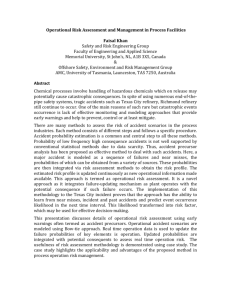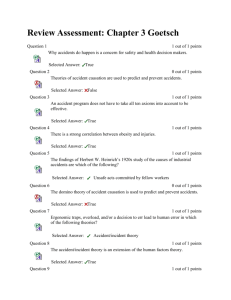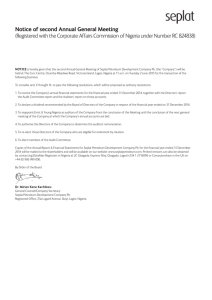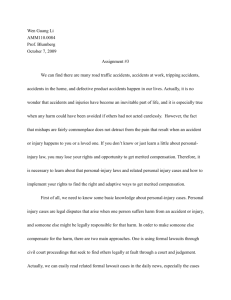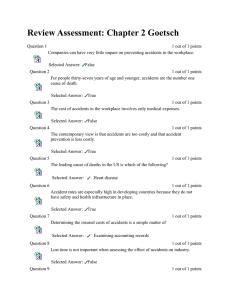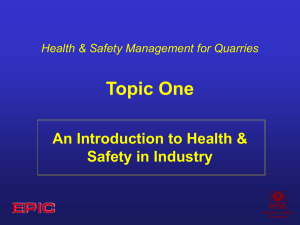Document 10467270
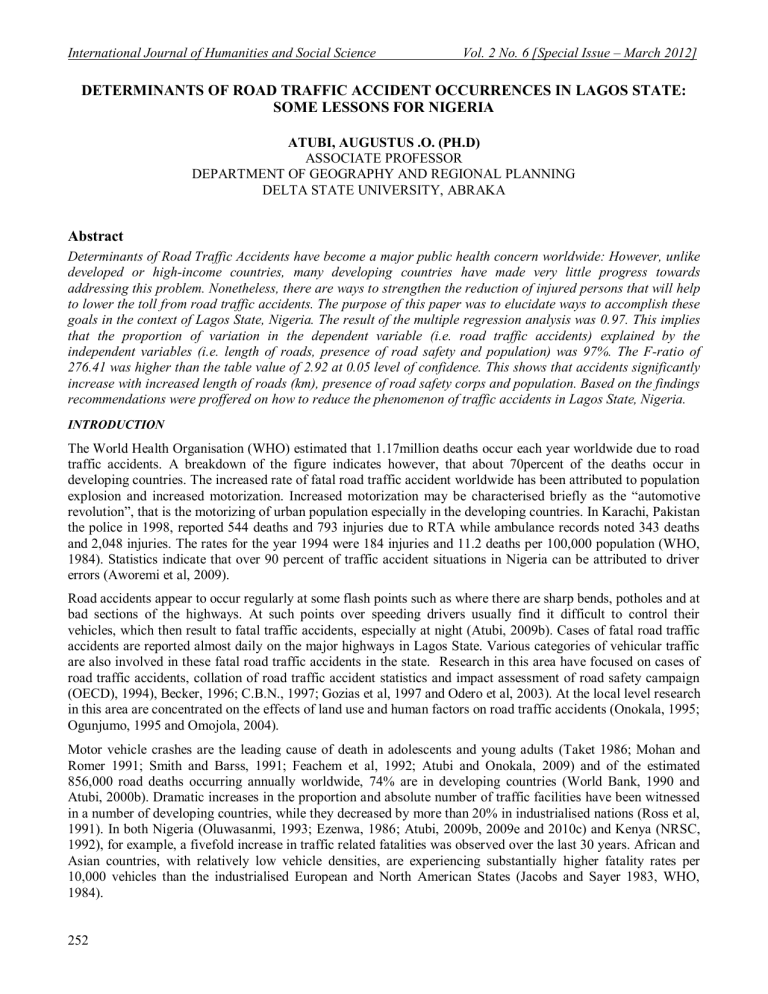
International Journal of Humanities and Social Science Vol. 2 No. 6 [Special Issue – March 2012]
DETERMINANTS OF ROAD TRAFFIC ACCIDENT OCCURRENCES IN LAGOS STATE:
SOME LESSONS FOR NIGERIA
ATUBI, AUGUSTUS .O. (PH.D)
ASSOCIATE PROFESSOR
DEPARTMENT OF GEOGRAPHY AND REGIONAL PLANNING
DELTA STATE UNIVERSITY, ABRAKA
Abstract
Determinants of Road Traffic Accidents have become a major public health concern worldwide: However, unlike developed or high-income countries, many developing countries have made very little progress towards addressing this problem. Nonetheless, there are ways to strengthen the reduction of injured persons that will help to lower the toll from road traffic accidents. The purpose of this paper was to elucidate ways to accomplish these goals in the context of Lagos State, Nigeria. The result of the multiple regression analysis was 0.97. This implies that the proportion of variation in the dependent variable (i.e. road traffic accidents) explained by the independent variables (i.e. length of roads, presence of road safety and population) was 97%. The F-ratio of
276.41 was higher than the table value of 2.92 at 0.05 level of confidence. This shows that accidents significantly increase with increased length of roads (km), presence of road safety corps and population. Based on the findings recommendations were proffered on how to reduce the phenomenon of traffic accidents in Lagos State, Nigeria.
INTRODUCTION
The World Health Organisation (WHO) estimated that 1.17million deaths occur each year worldwide due to road traffic accidents. A breakdown of the figure indicates however, that about 70percent of the deaths occur in developing countries. The increased rate of fatal road traffic accident worldwide has been attributed to population explosion and increased motorization. Increased motorization may be characterised briefly as the “automotive revolution”, that is the motorizing of urban population especially in the developing countries. In Karachi, Pakistan the police in 1998, reported 544 deaths and 793 injuries due to RTA while ambulance records noted 343 deaths and 2,048 injuries. The rates for the year 1994 were 184 injuries and 11.2 deaths per 100,000 population (WHO,
1984). Statistics indicate that over 90 percent of traffic accident situations in Nigeria can be attributed to driver errors (Aworemi et al, 2009).
Road accidents appear to occur regularly at some flash points such as where there are sharp bends, potholes and at bad sections of the highways. At such points over speeding drivers usually find it difficult to control their vehicles, which then result to fatal traffic accidents, especially at night (Atubi, 2009b). Cases of fatal road traffic accidents are reported almost daily on the major highways in Lagos State. Various categories of vehicular traffic are also involved in these fatal road traffic accidents in the state. Research in this area have focused on cases of road traffic accidents, collation of road traffic accident statistics and impact assessment of road safety campaign
(OECD), 1994), Becker, 1996; C.B.N., 1997; Gozias et al, 1997 and Odero et al, 2003). At the local level research in this area are concentrated on the effects of land use and human factors on road traffic accidents (Onokala, 1995;
Ogunjumo, 1995 and Omojola, 2004).
Motor vehicle crashes are the leading cause of death in adolescents and young adults (Taket 1986; Mohan and
Romer 1991; Smith and Barss, 1991; Feachem et al, 1992; Atubi and Onokala, 2009) and of the estimated
856,000 road deaths occurring annually worldwide, 74% are in developing countries (World Bank, 1990 and
Atubi, 2000b). Dramatic increases in the proportion and absolute number of traffic facilities have been witnessed in a number of developing countries, while they decreased by more than 20% in industrialised nations (Ross et al,
1991). In both Nigeria (Oluwasanmi, 1993; Ezenwa, 1986; Atubi, 2009b, 2009e and 2010c) and Kenya (NRSC,
1992), for example, a fivefold increase in traffic related fatalities was observed over the last 30 years. African and
Asian countries, with relatively low vehicle densities, are experiencing substantially higher fatality rates per
10,000 vehicles than the industrialised European and North American States (Jacobs and Sayer 1983, WHO,
1984).
252
The Special Issue on Behavioral and Social Science © Centre for Promoting Ideas, USA www.ijhssnet.com
Traffic crashes also impact on the economy of developing countries at an estimated cost of 1-2% of a country’s
GNP per annum, as a result of morbidity, mortality and property – related costs (Fouracre and Jacobs, 1976;
Jacbos and Sayer, 1983; WHO, 1989; Jabaan, 1989a and 1990; Downing, 1991). Causes of motor vehicle crashes are multi-factorial and involve the interaction of a number of pre-crash factors that include people, vehicles and the road environment (Haddon, 1980; AMA, 1983; Stansfield et al, 1992; Robertson, 1992). Human error is estimated to account for between 64 and 95% of all causes of traffic crashes in developing countries (TRL, 1990;
Atubi, 2009c). A high prevalence of old vehicles that often carry many more people than they are designed to carry, lack of safety belt and helmet use, poor road design and maintenance and the traffic mix on roads are other factors that contribute to the high rate of crashes in less developed countries.
Thirty-eight studies described casualties by the category of road-user. Pedestrian fatalities were highest in 75% of the studies accounting for between 41 and 75%, followed by passengers (38-51%) in 62% of the studies. Drivers were third in 55% of the studies, and never ranked first in any country. Pedal and motorcyclists killed ranked first in India (Mohan and Bawa, 1985; Sidhu et al 1993) and Surinam (CAREC, 1987). Passengers ranked first amongst the non-fatal casualties reported in 14 studies. Pedestrians were second, with the exception of one hospital based study by Dessie and Larson (1991) in Addis Ababa that reported a very high proportion of pedestrians, accounting for 91% of all traffic casualties.
Driver injuries were greater in Saudi Arabia (Bener and El-Sayyad, 1985; Ofosu et al, 1988), while motorcyclists were the most involved in Taiwan (Wu and Malison, 1990). A relatively high proportion of cyclist injuries in
South East Asian countries, ranging from 39 to 63%, reflect the effects of traffic mix on the roads in the region. In
Nigeria, road traffic accident situation over the last three decades has been particularly disturbing. In 1976, there were 53,897 road traffic accidents resulting in 7,717 deaths. Although in 1981, the magnitude reduced to 5,114 accidents, but the fatality increased to 10,236 which mean that there was an average of 96 accidents and 28 deaths for everyday of that year (Ogunsanya, 1991). The situation in subsequent years has not been any better. The number of people killed in road accidents between 1990 and 2005 rose from 28,253, and the fatality rate remains consistently high (Atubi, 2009c). International comparison indicates that the chance of a vehicle killing someone in Nigeria is 47 times higher than in Britain. The proportion of fatalities to injuries reported is also very high. For example, while Czech Republic has only one death in 175 accidents, France, one death in 175, South Africa, one death in 47 accidents, Nigeria has one death in 2.65 accidents (Atubi, 2010c).
Atubi (2010c) examined the variation patterns of RTA in Lagos state using data for 32 years (1970-2001) and observed the number and type of vehicles involved in road traffic accidents. The study revealed that private cars, buses and taxis were more prone to accidents in Lagos State. The 16 Harmonies as for the selected Local
Government Areas considered contribute above 90% of the total variance in the time series. This means that more than 90% of road traffic accidents in Lagos State could be attributed to recklessness on the part of drivers, ignorance of high way codes, over speeding etc. Also, the dominant cycles of road traffic accidents observed in this study area have periodicities of 32.00 and 16.00 years with the most dominant being 32 years. This means that the dominant and strongest road traffic accident pattern of Lagos State repeats itself every 32 years. Various road safety strategies and counter measures have been used at different stages of network development. This method of seeking to prevent road accident mainly involves conscious planning, design and operations of roads.
One of the most important factors in this method is the systematic identification and treatment of hazardous locations. The main objective of the study is to develop a model necessary to identify these hazardous locations on roads commonly termed as black spots. In general, the various factors that cause accidents can be broadly categorised into road related, vehicle related and driver related.
THE STUDY AREA
Lagos State is a suitable case study because it hosts metropolitan Lagos, Nigeria’s major traffic centre, fastest growing city, and most heavily motorized urban area in the country. Consequently, the state has one of the highest accident and casualty rates in the country (Table 1: Federal Republic of Nigeria, 1997, p. 6). Moreover, the traffic situation in Lagos State is bad because of the absence of effective planning, vehicle-misuse, poor management, inadequate street parking, traffic congestion, delays and accidents among other contributory factors. Lagos State is situated in the South Western corner of Nigeria. This elongated state spans the Guinea Atlantic coast for over
180km, from the Republic of Benin on the west to its boundary with Ogun State in the east (figure 1), while
Lagos State is the smallest in Nigeria, it has over 5 percent (i.e. 9,013,534) of the country’s estimated 140 million people (National Population Census, 2006).
253
International Journal of Humanities and Social Science Vol. 2 No. 6 [Special Issue – March 2012]
Its rate of population growth has been in excess of 9 percent per annum, or 25,000 per month or 833 per day or 34 per hours in the last decade (Lagos urban Transport Project, 2002). This population increase has been accompanied by a corresponding increase in motor vehicles and traffic accidents. However, accident rates in
Lagos State are still very much on the high side compared to other states in the federation. But, fatalities and nonsurvival indices for the state are on the decline. This is attributable to its high level of traffic congestion (which reduces the probability of the high fatality accidents resulting from over speeding) and accessibility to good post – crash medical care in the Lagos metropolitan area.
OGUN STATE
N
Alimo sho
Agege
Ifako
Ijaye
Ikej a
Ikorod u
Epe
Badag ry
Amu wo n
Oshodi/I solo
Oj
Surule n re
Mushi
Lagos
Mainland o
Ajero
Lag os nd
Apa pa dun
Eti-
Osa
Lagos
Lagoon
Ibeju/Le kki
G U L F O F B E
N I N
Key
OGUN
STATE
0 1
0
20 30k m
Water body
Int’l Boundary
State Boundary
L.G.A.
FIG. 1: MAP OF LAGOS STATE SHOWING THE 20 L.G.AS
SOURCE: LAGOS STATE MINISTRY OF ENVIRONMENT AND PHYSICAL
PLANNING (1999)
Table 1: Spatial variations in the area, population and accident parameters among the states of Nigeria,
States
Benue-Plateau
East-Central
Kano
(*000 sq. km)
108.4
22.7
43.1
Area
% of
Nation’s
Total
Population
(1985 estimates)
Number
(*000)
1970-1985
% of
Nation’s
Total
Population
Density
Per
Sq. Km
1985
11.02 4628.1
2.30 8621.6
4.38 6666.0
7.04
13.13
10.13
42.7
379.8
154.7
Accidents
per
100,000
Population
(6 yr.
Ave.)
19.63
22.74
18.50
Fatal
Accidents per
100,000
(6 yr.
Ave.)
4.62
3.36
2.81
Fatalities per
100,000
(6 yr.
Ave.)
6.30
4.05
3.61
Total
Causalities per
100,000
Population
6 yr. Ave.)
19.75
19.32
19.61
Kwara
Lagos
Mid-west
North-Central
North-Western
Rivers
Western
74.3
14.9
39.7
69.0
313.0
168.4
18.2
7.55 2777.6
1.52 1654.0
4.04 2927.0
7.10 1731.0
31.83 9021.5
17.12 6618.0
1.85 1782.7
4.23
2.52
4.45
7.20
13.73
10.07
2.71
Nigeria 35.1
Averages of the twelve state 75.4
Standard deviation
3.63
7.66
5340.2
10951.6
8.13
16.67
983.2 100.00 65720.3 100.00
Coefficient of variation
Authors Estimates Source: The Nigerian Police.
37.4
111.1
73.7
67.8
28.8
39.3
98.0
150.0
145.2
66.8
32.27
281.39
48.55
41.73
13.85
13.84
50.10
18.00
34.56
32.45
49.60
0.98
1.43
5.03
16.00
6.33
7.42
2.54
3.19
3.26
2.11
5.31
4.39
5.17
3.61
0.70
6.47
17.30
8.61
7.76
3.80
6.11
3.67
2.60
6.92
5.68
6.41
5.75
0.90
34.05
106.82
46.10
41.67
22.10
22.98
26.24
17.16
29.90
28.08
33.81
23.81
0.70
254
The Special Issue on Behavioral and Social Science © Centre for Promoting Ideas, USA www.ijhssnet.com
MATERIALS AND METHODS
This study, in a broad sense, undertakes an analysis of road traffic accidents in Lagos State, Nigeria. This is an attempt to conduct a detailed investigation of accident phenomenon more than the ones that had hitherto engaged the attention of researchers. Secondary data were collected from various sources, which include the r ecords of the
Federal Road Safety Commission, the Nigerian Police, Federal Ministry of Transport, and the Federal Office of
Statistics. The author, reviewed the statistics for the years 1970-2001, disaggregated by administrative councils.
The records contained information on crash severity (whether fatal, serious or slight), categories of road users affected, vehicles involved, and causes of crashes (whether human error, vehicle defect, or otherwise), data and traffic environment as judged by the investigating officers. Since the police only record crashes with immediate fatalities, their data generally under estimate the true magnitude of road traffic fatalities. The data collected were analysed using both descriptive and inferential statistics.
DISCUSSION OF FINDINGS
In order to ascertain the factors that influence the number of reported road traffic accidents in Lagos State, a multiple regression analysis was done. The dependent variable was reported number of road traffic accidents, while the independent variables considered include length of roads (in km) in Lagos state from 1970-2001, presence of road safety corps and population (appendix 1). Besides the road safety variable which was a dummy variable, 1 for years when the road safety corps are on the road, otherwise, the rest were in numbers. Out of the three regression models tried, linear form, logarithmic form and logarithmic to the power of two forms, the linear and the logarithmic to the power of two forms proved good considering the number of significant variables, sign of the coefficients and R
2
value. However, the linear form was chosen based on the Durbin-Watson statistic value of 2.118 as against that of double-log form which was 1.35.
The result of the analysis shows that the R
2
value was 0.967, this implies that the proportion of variation in the dependent variable (i.e. road traffic accidents) explained by the independent variables was 97%. The F-ratio of
276.41 was higher than the table value of 2.92 at 0.05 level of confidence. The choice of the three variables (i.e. length of roads, presence of road safety and population) was partly influenced by data availability. Other variables like alcohol induced accidents, over speeding and reckless driving would also have been useful but were not considered for lack of data. Table 1 shows the regression result.
Table 2: Regression Results of the Factors that influence road traffic accidents in Lagos State
Independent variables
Length of roads (km)
Presence of road safety
Population
Constant
Regression coefficients
10.651
2297.47
4.09x10
-4
-1099.17
S = Significant at 0.05 level of probability
Std. Error
3.343
421.32
0.000
767.68
T-start
3.186
5.45
4.51
-1.43
Remark
S
S
S
From table 2, length of roads in the study area (km), presence of road safety corps and population positively and significantly influenced road traffic accidents at the 0.05 level of probability in the study area. This shows that road accidents significantly increase with increased length of roads (km), presence of road safety corps and increased population. Thus, the greater the areal extent and length of highways, the higher the number of accident occurrences in Lagos State. While it is expected that large areas are likely to have greater accident occurrences than smaller areas because to higher traffic volumes, it is, however, note worthy that the more the highways of generally high quality, the greater the number of accidents. This result confirms findings from other studies that the better the quality of the roads in Nigeria, the higher the level of road traffic accidents in the country because drivers most likely over speed on good roads, leading to more frequent and fatal accidents (Onakomaiya 1988;
Filani and Gbadamosi, 2007).
This finding leads to two other conclusions; first, it suggests that constructing more roads will lead to increased road traffic accidents. Since increasing the number of roads may be beneficial in other ways, especially as government increases the road network as part of increasing the nation’s infrastructure base, the benefits of such developments will have to be balanced with the expected increase in road traffic accidents. Second, the findings suggest that there were more and significant levels of road traffic accidents in the periods when road safety corps was manning the road system.
255
International Journal of Humanities and Social Science Vol. 2 No. 6 [Special Issue – March 2012]
This is because the size of Nigeria’s traffic police force is too small for its road network and driver population.
Moreover, the force often stays on the major highways while most of the reported road traffic accidents occur in the densely populated and motorized municipal area. In general, the variability of road traffic accident occurrences within the study area in the 32 years period can be attributed to the variations in traffic density. This is because of improvements in the quality and density of roads has not led to appreciable changes in driving, safety provisions or stronger procedures for monitoring road users’ compliance with traffic rules and regulations across the country. Moreover, poor police practices, regional disparities in traffic police strength and inadequate facilities have limited their ability to effectively enforce traffic regulations, and by extension, their ability to be effective road safety agents.
It is clear from the study that the human factor is the most potent contributor to motor vehicle accidents in
Nigeria. This is not surprising because people pervade all aspects of traffic accident causation: from poor road construction, corrupt traffic law enforcement, to poor road user. The driver who disobeys road traffic regulations may be the doctor or nurse in the hospital where accident victims are treated. The law enforcement officer that has no tools to work with and display a nonchalant attitude to accident victims also contributes to their eventual death.
All these make the human factor the since qua non in the development of theory and the building of models for the explanation of and solution to the problem of road accidents in Nigeria and elsewhere. A fuller understanding of the many factors which contribute to road accidents in Nigeria is needed before effective measures can be applied to alleviate the present situation. Moreover, alleviating the situation requires a coordinated approach by all stakeholders including the Police, The Federal Road Safety Commission, teacher, parents, planners, doctors and individuals members of society.
IMPLICATION OF FINDINGS/RECOMMENDATIONS
For Nigeria, the measures in table 3 might help to reduce the country’s high road accident rated and improve her overall road safety.
Table 3: Suggested road accident prevention strategies for Nigeria
Ensuring that drivers are constantly trained to ensure that they operate vehicles safely and comply with traffic regulations at all times.
Learn from other countries with better traffic management systems e.g. the U.S. and Great Britain
Rationalise the use of traffic police check points
Ensure adequate funding for the Federal Road Safety Corps
To deal with the high accident situation in Lagos State, the authorities should:
First, decongest the CBD by staggering work hours so that all workers do not leave for work at approximately the same time. This would reduce the number of workers plying the roads during peak hours and thus ease traffic congestion in the peak hours. Second, strengthen the state’s traffic patrol effort by (i) ensuring that local traffic police work closely with the Federal Road Safety Commission (FRSC), (ii) Regularly patrolling the highways and side streets and, (iii) Ensuring that local police are familiar with the temporal and spatial distribution of road traffic accidents within the their area of jurisdiction.
Third, ensure that there is enough political commitment to deal with the long term issue of reducing road accidents; long term efforts to reduce the states high auto accidents rate requires (i) constant monitoring of the states roads (ii) dedicating enough resources to road safety in spite of extreme budgetary constraints, (iii) sufficient allocation of road safety research funds to identify problems in need of remedial action and to maintain up to-base data for road safety decision – making and public education and, (iv) Coordinating road safety polices at sub-regional and regional levels.
Fourth, implement preventive road accident measures including proper design of road networks as well as the planning of the general public transport system to ensure that it runs in an effective and efficient manner as this would reduce the volume of the vehicles plying the roads.
Fifth, consistently implement road safety measures that go beyond ad-hoc public pronouncements and traffic control activities on setting up of temporary road blocks or short-term crackdowns on commercial and private vehicles (usually after an important personality is killed in a crash). Such efforts should address broader road safety policy issues and the various underlying causes. For this to happen, it is important to enlist the necessary political good will and commitment to road traffic injury prevention.
256
The Special Issue on Behavioral and Social Science © Centre for Promoting Ideas, USA www.ijhssnet.com
Sixth invest in the repair of most Lagos roads, many of which are currently in need of repair and maintenance. For this to happen the institutional machinery needed to ensure the timely construction and repair of roads should be strengthened.
CONCLUSION
Traffic accident injuries and fatalities are a serious problem all over the world. In Nigeria, the incidence has become a very disturbing phenomenon as the country is presently ranked among countries with the highest traffic injuries and fatalities in the world (Jacobs et al, 1986; Onakomaiya, 1991; Daramola, 2004). Moreover, the country’s road safety campaigns are inadequate and often limited to festive seasons. At other times, such campaigns are often limited to media and roadside slogans like “drive carefully”, accident kill more passengers”,
“drive to stay alive”, and only living celebrates”. For these campaigns to be effective, they must be year-round and not just limited to festive seasons.
REFERENCES
American Medical Association (1983) Automobile-Related injuries: Components, Trends and Prevention. Journal of the American Medical Association , 249: 3216-3222.
Atubi, A.O. (2009b) “Urban Transportation: An Appraisal of Features and Problems in the Nigerian Society”.
International Journal of Geography and Regional Planning . Vol. 1, No. 1, Pp. 58-62.
Atubi, A.O. (2009c) Modelling Road Traffic Accidents in Lagos State, South Western Nigeria. Journal of Society and State . Vol. 1, No. 1 & 2, Pp. 57-74.
Atubi, A.O. (2010b) Road Transport System Management and Traffic in Lagos, South Western Nigeria. Journal of African Research Review . Vol. 4, No. 4, Pp. 459-470.
Atubi, A.O. (2010c) Road Traffic Accident Variations in Lagos State, Nigeria: A Synopsis of Variance Spectra.
Journal of African Research Review . Vol. 4, No. 2, Pp. 197-218.
Atubi, A.O. and Onokala, P.C. (2009) Contemporary Analysis of Variability in Road Traffic Accidents in Lagos
State, Nigeria. Journal of African Geographical Review . Vol. 28, Pp. 11-41.
Aworemi, A. and Alawode, E.C. (2009) Roads to where? Newswatch , December 30, 17 (13) 3.
Backer, W. (1996) “Impact Assessment of Road Safety Campaign”
Transportation Review . 16 (4): 345-355.
Bener, A. and El-Sayyad, G.M. 91985) Epidemiology of Motor Vehicle Accidents in Jeddeh. Journal of the Royal
Society of Health , 105:200-201.
CAREC (1987) Blood Alcohol Levels in Traffic Accident Victims, Surinam, February, 1987. CAREC Survivor
Report , 13, 1-14.
Central Bank of Nigeria (1997) Annual Report and Statement of Account for the Year Ended 31 st
December ,
CBN, Abuja.
Daramola, A.Y. (2004) “Innovative Options for Financing Transport Infrastructure in Nigeria” In Nisereel,
The
Magazine of the Nigerian Institute of Social and Economic Research , Nos 4 & 5, December, Ibadan.
Dessie, T. and Larson, C.P. (1991): The Occurrence and Driver Characteristics Associated with Motor Vehicle
Injuries in Addis Ababa, Ethiopia. Journal of Tropical Medicine and Hygiene , 94:395-400.
Downing, A.J. (1991) Driver Training of Africa: the UN-ECA Driving Manual. Proceedings of the Second
African Road Safety Congress . Oslo: Institute of Transport Economics (TOI)
Ezenwa, A.O. (1986) “Prevention and Control of Road Traffic in Nigeria” Journal of the Royal Society of Health .
Vol. 106, No. 1, Pp. 25-26.
Feachem, R.G.A,; Kjellstorm, T,; Murray, C.J.L.; Over, M. and Philips, M.A. (1992) The Health of Adults in the
Developing World , London: Oxford University Press.
Filani, M.O. and Gbadamosi, K.T. (2007) Spatial and Temporal Pattern of Road Traffic Accident Occurrences in
Nigeria: 1970-1995. Nigerian Geographical Journal . Vol. 5, No. 1, Pp. 55-70.
Fouracre, P. R. and Jacobs, G.D. (1976) Comparative Accident Costs in Developing Countries. TRRL
Supplementary Report 206 . Crowthorne: Transport and Road Research Laboratory.
Gozias, J.C.; Matsouki, E.C. and Yannis, G.D. (1997) “An Analysis of Factors Affecting Road Safety: The Greek
Experience” Journal of Transportation Geography 5 (3): 325-316.
Haddon, W. (1980) Advances in the Epidemiology of Injuries as a basis for public policy. Public Health Reports .
95: pp. 411-421.
257
International Journal of Humanities and Social Science Vol. 2 No. 6 [Special Issue – March 2012]
Jacobs, G.D. and Cutting, C.A. (1986) “Further Research on Accident Rates in Developing Countries”.
Accident
Analysis and Prevention . Vol. 18, No. 2, pp. 119-127.
Jacobs, G.D. and Sayer, I.A. (1983) Road Accidents in Developing Countries’. Transport and Road Research laboratory, TRRI Supplementary Report 897 Crowthorne.
Jadaan, K.S. (1989a) Road Accidents Costs in Jordan. Journal of the Royal Society of Health , 109: 144-146.
Jadaan, K.S. (1990) Traffic Accidents in Kuwait: An Economic Dimension. Accident Analysis and Prevention .
22:399-401.
Mohan, D. and Bawa, P.S. (1985) An Analysis of Road Traffic Accident Fatalities in Delhi, India. Accident
Analysis and Prevention , 17: 33-45.
Mohan, D. and Romer, C.J. (1991) Accident Mortality and Morbidity in Developing Countries. In Manciaux M. and Romer, C.J. (ed) Accidents in Childhood and Adolescence: The Role of Research , Pp. 31-38. Geneva:
World Health Organisation.
National Road Safety Council of Kenya (1992) Accident Statistics, 1983-1990 . Nairobi: Ministry of Public
Works, Government of Kenya.
Odero, W. Khayes, I.M. Meda, P. M. (2003) Road Traffic Accident in Kenya: Magnitude, Causes and Status of
Intervention. Injury Control and Safety Promotion , 10, Pp. 53-61.
OECD, (1994) Managing the Environment: the Role of Economic Instrument . Paris
Ofosu, J.B.; Abonammoh, A.M. and Bener, A. (1988): A Study of Road Traffic Accidents in Saudi Arabia.
Accident Analysis and Prevention , 20:95-111.
Ogunjumo, A. (1995) En Evaluation of Nigerian Airways’ and Foreign Management Consultants’ domestic
Operations: 1974-1986: The Nigerian Journal of Economic and Social Studies , Pp. 34 (1).
Ogunsanya, A.A. (1991) Empirical Cases Studies of Accident and Safety Control of Mass Transit Agencies in
Nigeria. In Bolade T, and Ogunsanya A. (eds) Accident Control and Safety measures in Mass Transit
Operations in Nigeria . Ibadan: University Press. Pp. 87-115.
Oluwasanmi, A.J. (1993) Road Accident Trends in Nigeria. Accident Analysis Prevention 25 (4) Pp. 485-487.
Omojola, A.S.(2004) “Transport and Communication” in Kayode, M.O. and Usman, Y.B. (eds) Nigeria since
Independence . Vol. 2, Ibadan; Heinemann. Pp. 132-152.
Onakomaiya, S.O. (1988) Unsafe at any Speed: Toward Road Transportation for Survival: Inaugural Lecture ,
University of Ilorin, Ilorin.
Onakomaiya, S.O. (1991) General Trend of Safety and Accident Records in Nigerian Transport Sector. In: Bolade
T. and Ogunsanya, A. (eds) Accident Control and Safety Measures in Mass Transit Operation in Nigeria ,
Ibadan University Press, P. 11.
Onokala, P.C. (1995) The Effect of Landuse on Road Traffic Accident in Benin-City, Nigeria. Journal of
Transport Studies , Vol. 1, No. 1, Pp. 34-44.
Robertson, L.S. (1992) Injury Epidemiology . Oxford University Press, New York.
Ross, A. Baguley, C. Hills, V. Mchonald, M. and Silcock, d. (1991) Towards Safer Roads in Developing
Countries: A guide for Planners and Engineers . Crowthorne, U.K.; Transport Research laboratories.
Sidhu, D.S.; Sodi, G.S. and Banerjee, A.K. (1993) Mortality Profile in Trauma Victims. Journal of the Indian
Medical Association , 1:16-18.
Smith, G.S. and Barss, P. (1991) Unintentional Injuries in Developing Countries: The Epidemiology of a neglected problem. Epidemiology Review . 13, 228-266.
Stansfield, S.K.; Smith, J.S. and McGreevey, W.P. (1992) Injury. In Diseases Priorities in Developing Countries .
(eds) Jamison, D.T. and Mosley, W.H. World Bank, Oxford University Press, London, Pp. 609-633.
Taket, A. (1986) Accident Mortality in Children, Adolescence and Young Adults. World Health Statistics
Quarterly , 39:232-256.
Transport and Research Laboratory (1999) Towards Safer Roads in Developing Countries , TRL, Crowthorne, U.K.
World Bank (1990) “Road Safety Problem in the Third World”. The Urban Edge . Vol. 14, No. 1.
World Health Organisation (1984) Road Traffic Accidents in Developing Countries, Geneva: WHO, TRS 703
World Health Organisation (1989) Analysis of Achievements of Traffic Safety in Industrialised and Developed
Countries .
Wu, S.I. and Malison, M.D. (1990) Motor Vehicle Injuries in Taiwan. Asia Pacific Journal of Public Health ,
4:72-75.
258
The Special Issue on Behavioral and Social Science © Centre for Promoting Ideas, USA www.ijhssnet.com
APPENDIX I
Population, length of roads (in km), and presence of road safety corps in Lagos State from 1970-2001
Year Population Length of roads (km)
Road safety presence
1970
1971
1,028,327
1,085,913
140
142
0 (No)
0
1972
1973
1974
1975
1,146,724
1,210,940
1,278,752
1,350,362
144
147
150
152
0
0
0
0
1976
1977
1978
1979
1980
1,425,982
1,505,836
1,647,384
1,802,238
1,971,648
154
156
157
157
157
0
0
0
0
0
1988
1989
1990
1991
1992
1993
1994
1995
1996
1997
1998
1981
1982
1983
1984
1985
1986
1987
2,156,982
2,359,938
2,581,553
2,824,218
3,089,694
3,380,125
3,697,856
4,024,554
4,425,726
4,842,744
5,680,000
6,213,920
6,790,028
7,097,141
7,416,512
7,661,256
7,914,077
8,175,241
158
161
164
160
148
144
130
130
130
130
135
135
150
194
197
203
200
250
0
0
0
0
0
1 (yes)
1
1
1
1
1
1
1
1
1
1
1
1
1999
2000
8,445,025
8,723,709
250
256
2001 9,011,591 300
Source: Lagos Metropolitan Area Transport Authority
1
1
1
(LAMATA, 2002); Master Plan Project, Urban and Regional Planning Division, Lagos State Ministry of
Economic Planning and Land Matters, 2002.
* There was a decline in length of roads in the country between 1985 and 1992 because these were the years of military rule in Nigeria and the various ministry regimes of that era disregarded the development of infrastructure such as roads. Moreover, flagrant abuse of power and massive corruption greatly diminished the resources available for road and other infrastructural developments.
259

